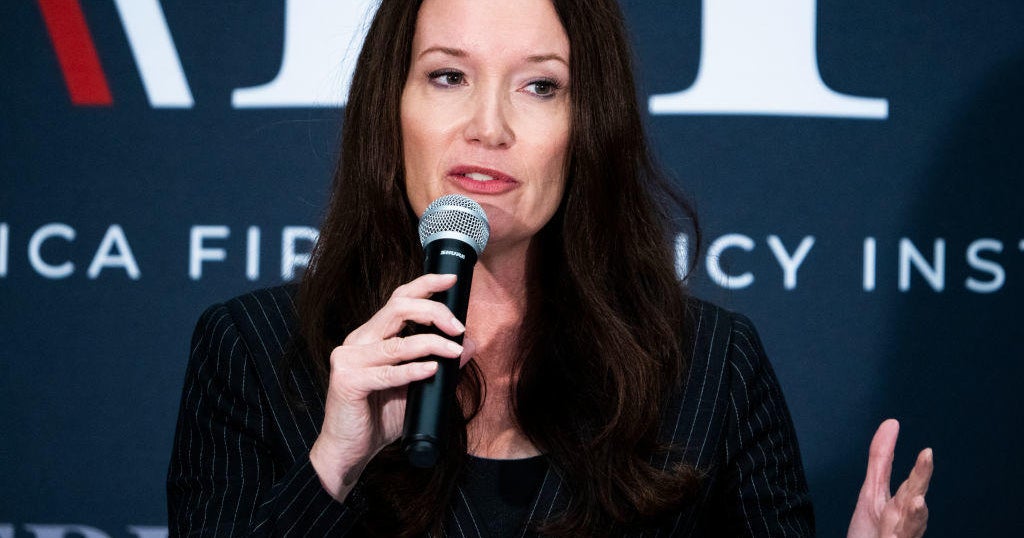CBS News
2 Al Jazeera staffers killed in Gaza bring journalist deaths to 113 since Israel-Hamas war started, group says

Al Jazeera reporter Ismail al-Ghoul and photographer Rami al-Refee were killed Wednesday in an Israeli strike in Gaza, becoming at least the 112th and 113th journalist or media worker — the vast majority of whom are Palestinian — to be killed since the war between Israel and Hamas began, according to data compiled by the Committee to Protect Journalists. The period since the start of the war has been the deadliest for journalists since the CPJ began gathering data in 1992.
“This is the second strike on an Al Jazeera journalist in a car,” CPJ CEO Jodie Ginsberg told CBS News. “That raises really disturbing questions about whether or not journalists are being deliberately targeted. … Whenever you see a case in which it appears that a particular building or a particular car has been targeted, and other cars or buildings in the area have been left alone, then that gives you reason to suspect that those places have been deliberately targeted, and of course, journalists are civilians and should never be targeted.”
The two journalists were reporting from near the Gaza home of Ismail Haniyeh, the political leader of Hamas who was assassinated in Iran earlier Wednesday.
OMAR AL-QATTAA/AFP/Getty
Al Jazeera called the killing of its journalists a “cold blooded assassination.”
CBS News asked the Israel Defense Forces if the news team’s vehicle had been targeted and, if so, why, but had not received any response by the time of publication.
As of July 31, 108 Palestinian journalists, two Israeli journalists and three Lebanese journalists have been killed in Gaza, according to the CPJ. Dozens more have been reported injured or arrested.
“Journalists have been paying the highest price — their lives — for their reporting. Without protection, equipment, international presence, communications or food and water, they are still doing their crucial jobs to tell the world the truth,” CPJ Program Director Carlos Martinez de la Serna said.
Israel has rarely permitted any international journalists to enter Gaza since the war there began, so reporting on the conflict in the besieged enclave has fallen to local journalists, who’ve been both covering and living through the fighting and the humanitarian crisis caused by it for months.
“That places a huge burden on local journalists, because they’re not only having to do reporting in these extraordinarily difficult conditions, but then almost having to prove every every time to the outside world that they’re trustworthy in a way that, you know, we didn’t necessarily see when Ukrainians were reporting on the war in Ukraine,” Ginsberg told CBS News.
OMAR AL-QATTAA/AFP/Getty
In addition to the physical risks and hardships they face, journalists in Gaza face a myriad of other kinds of attacks that make their lives and work more dangerous, the CPJ says, citing numerous arrests, cyberattacks, threats, assaults, and censorship the group has documented.
“We see trolling campaigns, hate campaigns against individual journalists looking for anything that might be evidence that they’re not trustworthy,” Ginsberg said.
“It can put [journalists] in danger because they might then be considered targets within Gaza, but it also happens outside even in Israel where those journalists find themselves to be much more vulnerable and might be harassed online, or what we’ve seen done is physically harassed as well,” Ginsberg told CBS News.
“As every day goes by, and you have fewer and fewer journalists reporting [in Gaza], that means you have less and less information coming out about what’s happening, and that creates a situation in which the international community potentially loses interest, and that’s incredibly dangerous in any conflict,” Ginsberg said. “Being able to report what’s happening is intrinsically linked to being able to affect change.”
CBS News
Trump picks former White House aide Brooke Rollins to lead the USDA

President-elect Donald Trump said Saturday that he will nominate former White House aide Brooke Rollins to be his agriculture secretary, the last of his picks to lead executive agencies and another choice from within his established circle of advisers and allies.
The nomination must be confirmed by the Senate, which will be controlled by Republicans when Trump takes office Jan. 20, 2025. Rollins would succeed Tom Vilsack, President Biden’s agriculture secretary who oversees the sprawling agency that controls policies, regulations and aid programs related to farming, forestry, ranching, food quality and nutrition.
Rollins, who graduated from Texas A&M University with a degree in agricultural development, is a longtime Trump associate who served as his former domestic policy chief. She is president and CEO of the America First Policy Institute, a group helping to lay the groundwork for a second Trump administration.
Tom Williams/CQ-Roll Call, Inc via Getty Images
Rollins, 52, previously served as an aide to former Texas Gov. Rick Perry and ran a think tank, the Texas Public Policy Foundation.
Rollins’ pick completes Trump’s selection of the heads of executive branch departments, just two and a half weeks after the former president won the White House once again. Several other picks that are traditionally Cabinet-level remain, including U.S. Trade Representative and head of the Small Business Administration.
Trump didn’t offer many specifics about his agriculture policies during the campaign, but farmers could be affected if he carries out his pledge to impose widespread tariffs. During the first Trump administration, countries like China responded to Trump’s tariffs by imposing retaliatory tariffs on U.S. exports like the corn and soybeans routinely sold overseas. Trump countered by offering massive multibillion-dollar aid to farmers to help them weather the trade war.
President Abraham Lincoln founded the USDA in 1862, when about half of all Americans lived on farms. The USDA oversees multiple support programs for farmers; animal and plant health; and the safety of meat, poultry and eggs that anchor the nation’s food supply. Its federal nutrition programs provide food to low-income people, pregnant women and young children. And the agency sets standards for school meals.
Robert F. Kennedy Jr., Trump’s nominee to lead the Department of Health and Human Services, has vowed to strip ultraprocessed foods from school lunches and to stop allowing Supplemental Nutrition Assistance Program beneficiaries from using food stamps to buy soda, candy or other so-called junk foods. But it would be the USDA, not HHS, that would be responsible for enacting those changes.
In addition, HHS and USDA will work together to finalize the 2025-2030 edition of the Dietary Guidelines for Americans. They are due late next year, with guidance for healthy diets and standards for federal nutrition programs.
CBS News
North Dakota Badlands national monument proposed with tribes’ support

A coalition of conservation groups and Native American tribal citizens on Friday called on President Joe Biden to designate nearly 140,000 acres of rugged, scenic Badlands as North Dakota’s first national monument, a proposal several tribal nations say would preserve the area’s indigenous and cultural heritage.
The proposed Maah Daah Hey National Monument would encompass 11 noncontiguous, newly designated units totaling 139,729 acres in the Little Missouri National Grassland. The proposed units would hug the popular recreation trail of the same name and neighbor Theodore Roosevelt National Park, named for the 26th president who ranched and roamed in the Badlands as a young man in the 1880s.
“When you tell the story of landscape, you have to tell the story of people,” said Michael Barthelemy, an enrolled member of the Mandan, Hidatsa and Arikara Nation and director of Native American studies at Nueta Hidatsa Sahnish College. “You have to tell the story of the people that first inhabited those places and the symbiotic relationship between the people and the landscape, how the people worked to shape the land and how the land worked to shape the people.”
The U.S. Forest Service would manage the proposed monument. The National Park Service oversees many national monuments, which are similar to national parks and usually designated by the president to protect the landscape’s features.
Supporters have traveled twice to Washington to meet with White House, Interior Department, Forest Service and Department of Agriculture officials. But the effort faces an uphill battle with less than two months remaining in Biden’s term and potential headwinds in President-elect Trump’s incoming administration.
If unsuccessful, the group would turn to the Trump administration “because we believe this is a good idea regardless of who’s president,” Dakota Resource Council Executive Director Scott Skokos said.
Dozens if not hundreds of oil and natural gas wells dot the landscape where the proposed monument would span, according to the supporters’ map. But the proposed units have no oil and gas leases, private inholdings or surface occupancy, and no grazing leases would be removed, said North Dakota Wildlife Federation Executive Director John Bradley.
The proposal is supported by the MHA Nation, the Spirit Lake Tribe and the Standing Rock Sioux Tribe through council resolutions.
If created, the monument would help tribal citizens stay connected to their identity, said Democratic state Rep. Lisa Finley-DeVille, an MHA Nation enrolled member.
North Dakota Gov. Doug Burgum is Trump’s pick to lead the Interior Department, which oversees the National Park Service. In a written statement, Burgum said: “North Dakota is proof that we can protect our precious parks, cultural heritage and natural resources AND responsibly develop our vast energy resources.”
North Dakota Sen. John Hoeven’s office said Friday was the first they had heard of the proposal, “but any effort that would make it harder for ranchers to operate and that could restrict multiple use, including energy development, is going to raise concerns with Senator Hoeven.”
CBS News
New Mexico city reaches $20 million settlement in death of woman fatally shot by officer

A city in New Mexico has reached a $20 million settlement with the family of a woman who was shot and killed by a police officer now charged with second-degree murder.
Teresa Gomez, 45, was fatally shot in October 2023 shortly after a Las Cruces police officer on a bicycle approached her while she sat in a parked car with another person, authorities said. Body camera video shows the officer shot Gomez three times as she tried to drive away.
The officer, identified by the city as Felipe Hernandez, was charged in January and fired months later from the Las Cruces Police Department.
“This settlement should be understood as a statement of the City’s profound feeling of loss for the death of Gomez and of the City’s condolences to her family,” the city of Las Cruces said in a news release sent Friday.
Hernandez has pleaded not guilty to the murder charge. His trial is scheduled for June 2. The Associated Press sent an email Saturday seeking comment from Hernandez’s attorney.
A lawyer for the Gomez family said her relatives are grateful to the city “for recognizing the injustice of Teresa’s death,” the Las Cruces Sun-News reported.
“They trust that the city will redouble efforts to make sure no other family suffers the tragedy of losing a loved one to abusive police conduct,” Shannon Kennedy said in a statement to the newspaper.












